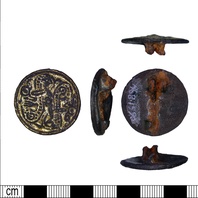
Viking Objects
Copper-Alloy Jellinge-Style Brooch (LEIC-36241D)
This brooch contains two S-shaped zoomorphic Jellinge-style designs around a central boss. For more information on Scandinavian jewellery in England check out our blog: Brooches, Pendants and Pins: Scandinavian Dress Accessories in England.
Read More
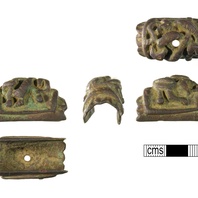
Viking Objects
Urnes-Style Sword Mount (WMID-2FF927)
A cast copper-alloy fitting with Urnes-style, zoomorphic decoration, found near Boylestone, Derbyshire. It may have been a pommel mount and, if so, would have showed off the wealth of the owner.
Read More
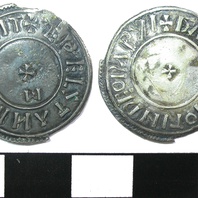
Viking Objects
Silver Penny (1914/543-1)
This silver penny of King Aethelstan, who was King of England from 927-939, was minted in Derby by the moneyer Gadierd between 937-939. It is not known where it was found. Moneyers were people who were permitted to mint money on behalf of the king. Minting coins was a way of controlling the means of exchange within a kingdom and which created a more easily administered standardized system of trade. Moreover, the coins themselves were often used as propaganda, portaying symbols and statements that gave off a desired message. The Vikings later used the minting of coins to legitimize their own rule.
Read More
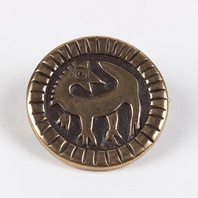
Viking Objects
Reproduction Brooch with Backwards-Facing Beast
A reproduction of a copper alloy disc brooch featuring a backwards-facing beast motif. This style of brooch would have been an everyday item rather than a high status one. For more information on Scandinavian jewellery in England check out our blog: Brooches, Pendants and Pins: Scandinavian Dress Accessories in England.
Read More

Viking Objects
Coin of Cnut the Great (NARC-9AE391)
This silver Helmet IIIc Type penny was minted for King Cnut of England by the moneyer Eadwine in Thetford. The obverse displays + CNUT RECXA with a figure wearing a pointed helmet. The reverse displays + EDPINE ON DEOD and a voided short cross. Minting coins was a way of controlling the means of exchange within a kingdom and which created a more easily administered standardized system of trade. Moreover, the coins themselves were often used as propaganda, portaying symbols and statements that gave off a desired message. The Vikings later used the minting of coins to legitimize their own rule.
Read More
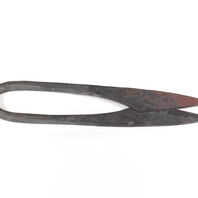
Viking Objects
Reproduction Shears
Shears were a common agricultural implement generally used to cut the wool off sheep but could also have been used as scissors in textile production. These are based on a number of originals uncovered during the excavations at Flixborough, Lincolnshire.
Read More
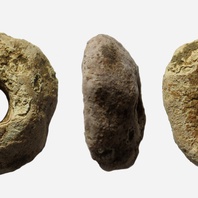
Viking Objects
Spindle-Whorl (LEIC-8D89EA)
A small, plain, undecorated lead-alloy spindle-whorl. Fibres were spun into thread using a drop-spindle of which the whorls were made of bone, ceramic, lead or stone and acted as flywheels during spinning.
Read More
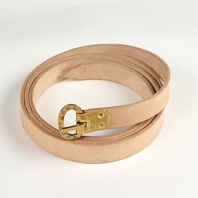
Viking Objects
Reproduction Belt
A vegetable-tanned leather belt with a decorated copper alloy belt buckle. The buckle has a ring and dot pattern and is based on one found in Grave 511 at Repton, Derbyshire.
Read More
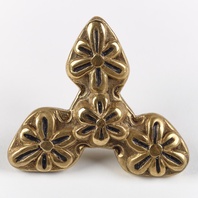
Viking Objects
Reproduction Trefoil Mount
A reproduction of copper alloy and gilded Carolingian mount with niello inlay found in Leicestershire. The mount has holes drilled through it for affixing to a surface, possibly a book, or perhaps to repurpose it as a pendant. These would have most likely been brought over by Vikings who had raided or traded on the European continent.
Read More
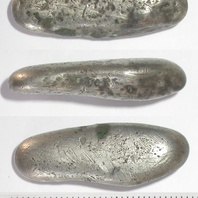
Viking Objects
Silver Ingot (DENO-CE6103)
This silver ingot was made by melting down worked silver and casting it in an open mould. The Vikings arriving in England had a bullion economy in which they paid for goods with silver that was weighed to an amount agreed between the buyer and the seller. Hacksilver and silver ingots are the most common evidence for their bullion economy. It took some time for the Scandinavian settlers to adopt a monetary economy like that of the Anglo-Saxons, and both systems were used simultaneously for a while before they fully adopted the new system. The Vikings were familiar with monetary economies but they treated coins as just another form of silver before adoption of a monetary economy.
